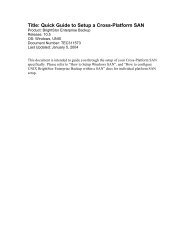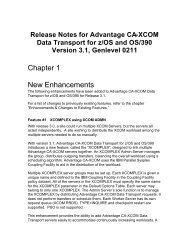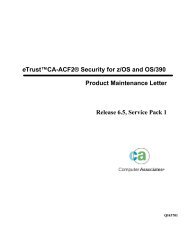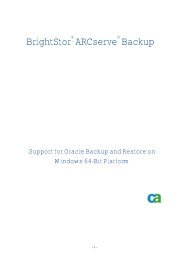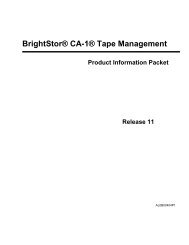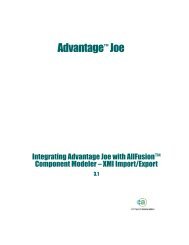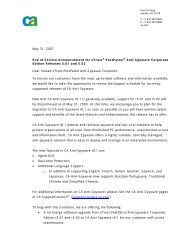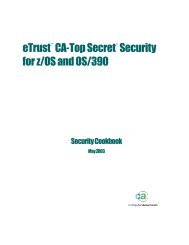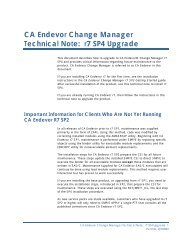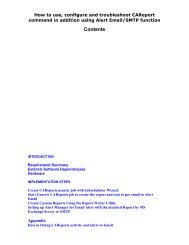Unicenter AutoSys Job Management Integration ... - SupportConnect
Unicenter AutoSys Job Management Integration ... - SupportConnect
Unicenter AutoSys Job Management Integration ... - SupportConnect
You also want an ePaper? Increase the reach of your titles
YUMPU automatically turns print PDFs into web optimized ePapers that Google loves.
Chapter<br />
1<br />
Working with eTrust Access<br />
Control and <strong>Unicenter</strong> <strong>AutoSys</strong><br />
<strong>Job</strong> <strong>Management</strong><br />
With the arrival of <strong>Unicenter</strong> <strong>AutoSys</strong> <strong>Job</strong> <strong>Management</strong> 4.5, an external security<br />
methodology is now provided through eTrust Access Control (eTrust AC). By<br />
utilizing eTrust AC, job scheduling administrators are able to provide a more<br />
granular level of control towards defining job attributes and administer<br />
application level control to ensure security and enforce standards. The purpose<br />
of this guide is to describe the integration between eTrust AC and <strong>Unicenter</strong><br />
<strong>AutoSys</strong> <strong>Job</strong> <strong>Management</strong> as well as provide examples you can possibly find in<br />
the real world. This document can be used in providing a quick start in<br />
implementing an <strong>Unicenter</strong> <strong>AutoSys</strong> <strong>Job</strong> <strong>Management</strong> environment secured<br />
through eTrust AC.<br />
Architecture<br />
eTrust AC as a standalone solution provides security to servers through a<br />
client/server subscription model. Within an enterprise, an administrator installs<br />
an eTrust server master database, otherwise referred to as a Policy Model<br />
Database (PMDB). This eTrust server acts as the parent server for which eTrust<br />
clients could subscribe to receive policy rules. eTrust clients store policy rules in<br />
a local database, known as a seosdb. After an eTrust client is subscribed to an<br />
eTrust Server, the PMDB pushes out all access control rules to the eTrust client<br />
database (seosdb). The benefit of having such an architecture is that the security<br />
administrator only needs to update the PMDB, and after doing so, the newly<br />
created policy will be pushed out to all subscribed clients.<br />
Working with eTrust Access Control and <strong>Unicenter</strong> <strong>AutoSys</strong> <strong>Job</strong> <strong>Management</strong> 1–1



